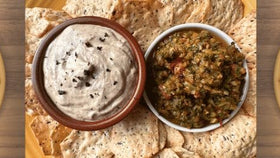Why Do Some Vanilla Beans Have Tattoos?
What Are Vanilla Bean Tattoos?
The first time someone hears the words “vanilla bean tattoos”, their mind probably wanders to visualizations of chefs sporting culinary inspired body art—orchids and vanilla beans permanently etched into their skin with the assistance of barred needles and ink. While there are plenty of tattoos that match this description, they have nothing to do with the ones we will be covering here.
The vanilla bean tattoos we are referring to do require needles, but there is no ink involved. In fact, they actually aren’t true tattoos at all; they’re scars intentionally inscribed into the pods of vanilla beans by the farmers themselves.
Let’s explore why tattooing vanilla beans has become a common practice for many farmers, the technique used for marking these beans, source regions of tattooed vanilla pods, and whether or not the vanilla quality is impacted.
Everything you want to know about Vanilla Bean Tattoos.
Vanilla beans are pretty magical. Can you imagine cookies or cakes without that delicate, rummy flavor infused into them? What about ice cream? Vanilla beans are prized by chefs and home cooks around the world for good reason, but behind these culinary gems is an alarming backstory—one that has led to the need for vanilla bean tattoos.
Read on to learn everything you need to know about vanilla bean tattoos, so you can make your next vanilla bean purchase with confidence.
What are vanilla bean tattoos used for?
The reasoning behind tattooing vanilla beans is related to that alarming backstory I mentioned earlier, one that is rooted deeply in supply and demand.
You see, there are many factors that have contributed to the high prices of vanilla beans. Of course, the popularity of the unmistakable flavor of vanilla has lent itself to the price point, but there are many other reasons.
Vanilla beans are the fruit of the vanilla orchid, a gorgeous, vine-like plant that blooms just once a year. When it blooms, there is a window of just 12-24 hours to get that flower pollinated. Further complicating the situation is the fact that there are few natural pollinators of the plant, meaning hand pollination is required. Once the plant has been pollinated, the farmers then have to wait about 9 months before they begin harvesting, another process that is done manually by cutting each bean from the vine. Next, are the curing and drying stages. You guessed it, these processes are also laborious and done primarily by hand.
Also giving rise to the price point are weather events, such as a cyclone that hit Madagascar in 2017, drastically decreasing the global vanilla supply.
Because the worldwide demand is so high and supply is relatively low in comparison, the willingness to pay has surged. Unfortunately, the skyrocketing prices has incentivized theft and armed robberies are threatening the livelihood of farmers.
Farmers needed to take action, so they began implementing security measures. One of the most inexpensive solutions is by “tattooing” the pods of their crop. Much like cattle branding, vanilla bean tattoos exist as a means of identification and a deterrent to thieves.
Learn more about the price of vanilla beans and how you can ensure you are not contributing to these crimes.
Is there a technique for tattooing vanilla beans?
So now that we know why these vanilla bean tattoos exist, let’s examine how they get there. As noted earlier, they aren’t actually tattoos at all. No ink is used in the marking of beans. Instead, the beans are poked with fine needles, which produces scars.
The farmers use the needles to engrave their initials into the green pods of the beans, using a poking process to form clusters of tiny dots in a small area of each bean. To the untrained eye, these markings may appear to be imperfections created by insects or disease, but they do not alter the quality or flavor of the beans in the slightest.
Are vanilla beans with tattoos safe for consumption?
The quick answer to this question is, absolutely. The tattoos on vanilla beans are simply scars—tiny pokes on the skin of the bean that have healed, just as your skin would do. They are perfectly safe to use in all of your culinary undertakings.
There are instances of vanilla beans being classified as grade b because of their tattoos simply because many consumers will think they are caused by bug infestations or other issues. Most preparers don’t consider the tattoos imperfections and will not downgrade a bean from the gourmet classification based on the tattoo alone, but some will for no other reason but to avoid the customer service issues. At Slofoodgroup, we look at each bean, and if the rest of the bean is pristine, and the moisture level is on par, we will keep the bean as gourmet. However, if the scar is large and any identifying characteristics of an extract bean are present, we will downgrade that particular bean to a grade b, due to our own sorting standards and customer expectations.
Is tattooing vanilla beans only common in Madagascar?
Tattooing vanilla beans has become a common practice in almost every vanilla growing region but is most prominent in Madagascar, which is where this security method began. Madagascar is the world’s largest producer of vanilla beans, meaning tattoos are most noticeable from this region just because of the sheer volume. That said, since armed robberies and other crimes on vanilla farmers are being committed in just about every growing region, the tattoos are becoming much more common around the world.
*****
There you have it—everything you need to know about vanilla bean tattoos, from what they are to why they exist and everything in between.
You can find responsibly-sourced, high-quality vanilla beans on our online vanilla shop. When you get them, make sure you look closely. Have your vanilla beans been tattooed?







Slofoodgroup
Author